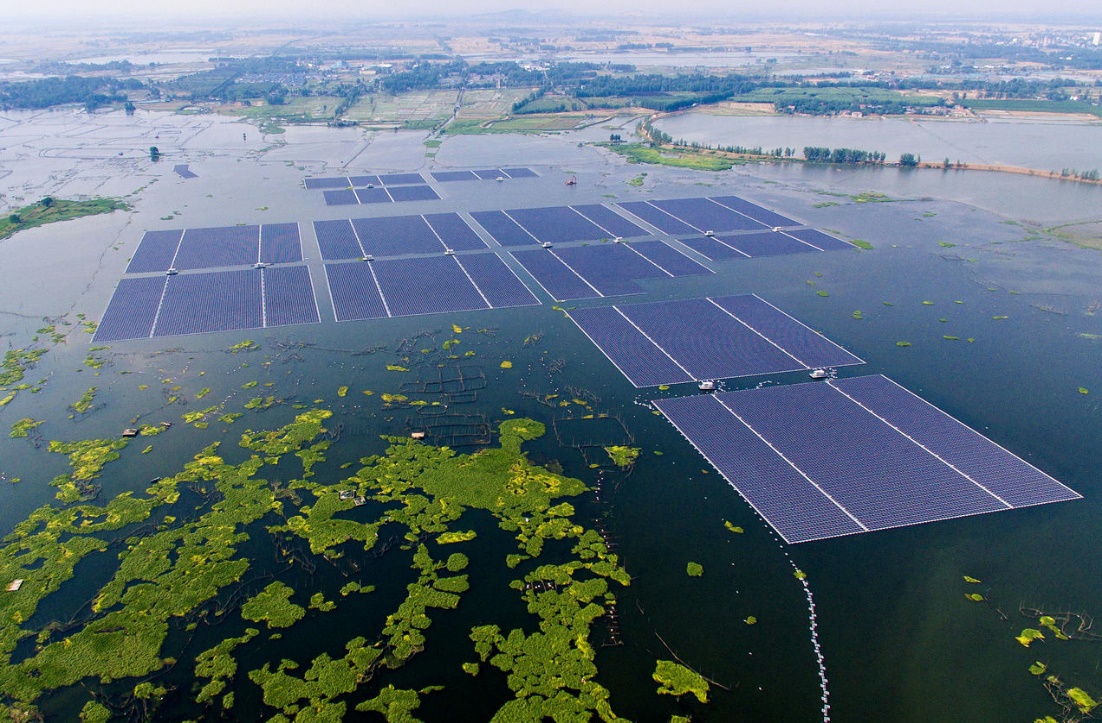Biodiversity & Environment
India’s Largest Floating Solar Power Project
- 02 Jul 2022
- 4 min read
For Prelims: Floating Solar Project, Solar Panels
For Mains: Benefits and challenges of Floating Solar Panels
Why in News?
Recently, the final 20 MW of the 100 MW Ramagundam floating solar PV project's commercial operation date was recently announced.
- With this, the 100 MW Ramagundam floating solar PV project in Telangana is declared operational from 1st July 2022.
- It is the largest project of its kind in India.
What are Floating Solar Panels?
- These are Photovoltaic (PV) modules mounted on platforms that float on water reservoirs, lakes, and where conditions are right seas and oceans.
- These platforms are typically moored on calmer bodies of water, such as ponds, lakes or reservoirs.
- These installations are relatively quick to construct, silent to run and require no land levelling or removal of vegetation.
What are its Key Highlights of Ramagundam Project?
- It is endowed with advanced technology and Environment-friendly features.
- The project spreads over 500 acres of the reservoir. Divided into 40 blocks, each having 2.5 MW.
- Each block consists of one floating platform and an array of 11,200 solar modules.
- The solar modules are placed on floaters manufactured with HDPE (High-Density Polyethylene) material.
- The entire floating system is anchored through special HMPE (High Modulus Polyethylene) rope to the dead weights placed in the balancing reservoir bed.
- This project is unique in the sense that all the electrical equipment including inverter, transformer, HT panel, and SCADA (Supervisory Control and Data Acquisition) are also on floating Ferro cement platforms.
What are the Environment Benefits of the Project?
- Limited Land Required:
- From an environmental point of view, the most obvious advantage is the minimum land requirement mostly for associated evacuation arrangements.
- Reduce Water Evaporation Rate:
- Further, with the presence of floating solar panels, the evaporation rate from water bodies is reduced, thus helping in water conservation.
- Approximately 32.5 lakh cubic meters per year of water evaporation can be avoided.
- Efficient in Reducing Co2 Emission:
- The water body underneath the solar modules helps in maintaining their ambient temperature, thereby improving their efficiency and generation. Similarly, while coal consumption of 1,65,000 Tons can be avoided per year; Co2 emission of 2,10,000 tons per year can be avoided.
What are the Related Challenges?
- Expensive to Install:
- More money is required to install floating solar panels than a traditional PV system.
- One of the main reasons is because the technology is relatively new, thus requires specialized knowledge and equipment.
- However, as the technology advances, its installations costs are also expected to drop.
- Limited Application:
- Many floating solar installations are large-scale, and they provide electricity to large communities, companies, or utility companies.
- Hence, choosing rooftop installation or ground-mounted solar is more practical.
- Understanding of Water-bed Topography:
- Developing floating solar projects requires a thorough understanding of water-bed topography and its suitability for setting up anchors for floats.
What are the other Solar Energy Initiatives?
- Solar Park Scheme
- Plan to build a number of solar parks, each with a capacity of nearly 500 MW, across several states.
- Rooftop Solar Scheme
- To harness solar power by installing solar panels on the roof of the houses.
- Atal Jyoti Yojana (AJAY):
- The AJAY scheme was launched in September 2016 for the installation of solar street lighting (SSL) systems in states with less than 50% households covered with grid power (as per Census 2011).





